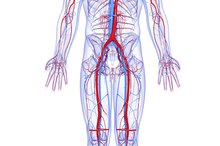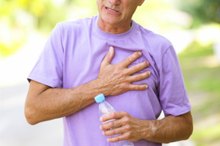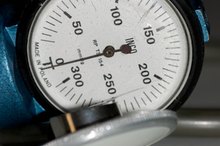What Is a Cardiac Workload?
Cardiac workload is how hard your heart has to work to pump blood throughout the body. It is influenced by the strength and frequency of muscle contractions in the heart, the amount of blood being pumped from the left ventricle, and arterial resistance. Blood is pumped from the left ventricle to the aorta and then into the arteries throughout the body. Cardiac workload is a measure of the demands placed on your heart and can be an indicator of coronary heart disease, or CHD. According to the University of Michigan Health System, if left untreated, a high cardiac workload can eventually lead to the veins, lungs and tissues becoming full of backed up fluid.
If you are experiencing serious medical symptoms, seek emergency treatment immediately.
Coronary Arterial Blood Supply
According to Patient Friendly, atherosclerosis, plaque in the arteries, and arteriosclerosis, hardening of the arteries, are both factors in limiting coronary blood flow. Since arterial blood carries oxygen to the body, this limits the amount of oxygen in the body, and the heart has to work harder. This increases the cardiac workload and heightens the risk of heart disease.
Risk Factors for High Cardiac Workload
Rapid Weight Loss in Congestive Heart Failure
Learn More
Nicotine is a primary factor because it stimulates the heart muscle, increasing the workload. Hardening of the arteries is another primary risk factor since the heart must work harder to push blood through arteries that have become resistant to blood flow. Other risk factors include high blood pressure or cholesterol, diabetes, obesity and physical inactivity.
Obesity
Increased fat in the chest or abdominal area is a prime risk factor for increase cardiac workload, notes Patient Friendly. Obesity often includes high blood pressure and high levels of cholesterol. A body type that carries fat in the abdomen or chest is also a risk factor for type 2 diabetes.
Lowering Cardiac Workload
How Do the Walls of the Atria & Ventricles Differ?
Learn More
The best ways to reduce the workload on your heart are to lose weight, control diabetes if you have it, quit smoking and get more exercise. Exercise strengthens the heart muscle and helps to improve circulation in the arteries. It also improves circulation in the veins that carry blood back to the heart. Exercise causes squeezing of the veins and help push blood back to the heart to be reoxygenated.
- The best ways to reduce the workload on your heart are to lose weight, control diabetes if you have it, quit smoking and get more exercise.
- It also improves circulation in the veins that carry blood back to the heart.
Related Articles
References
- National Institute on Aging: Aging Hearts and Arteries.
Writer Bio
Susan Landis-Steward has been a print journalist and editor since 1985, writing for "The Reflector," "The Multnomah Village Post," "The Evergreen Messenger" and "The Oregonian." She has won numerous awards for her reporting and has been published in top academic journals. Landis-Steward has a Master of Science in writing from Portland State University.






